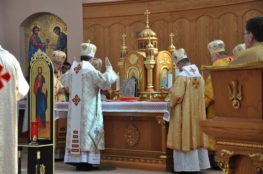Note: This post is the overdue second part of the fairly subjective reflection I wrote last month, “An Opening Remark on the Ways of Greek Catholicism in the West.” This “installment” concerns liturgy.
The phenomenon of “Latinizations” within the Greek Catholic churches remains a controversial topic, though perhaps less so than it was just a few decades ago. In two earlier entries, “A Note on Latinizations” and “Another Note on Latinizations,” I discussed the problems surrounding both the introduction and removal of spiritual-liturgical practices commonly associated with the Latin (Roman Catholic) West, albeit without offering anything close to a tidy solution. That’s because there isn’t one. As the history of liturgical reform (or upheaval) has shown, top-down efforts to alter the common liturgical experience of the faithful—one likely filled with para-liturgical elements as well—rarely ends well even if, over time, the original resentment fades and newer generations are, for better or worse, conditioned to a new liturgical reality. Going forward, the liturgical reality Greek Catholics will need to be conditioned to has less to do with “Latinizations” and more to do with upgrading the manner in which they serve the panoply of the Church’s liturgy. To a lesser, though still noticeable, extent, this is a problem facing Eastern Orthodox in the West as well.
Growing up I had almost no contact with the Byzantine services outside of the Divine Liturgy on Sundays and, at times, a highly truncated form of Matins (Orthros). Greek Catholic parishes in America, like many Orthodox ones, steadily abandoned most of their liturgical patrimony, becoming what Fr. Alexander Schmemann warned so strongly against, namely “Sunday churches.” Exceptions existed of course, particularly in larger metropolitan settings. Among the Orthodox, the Russian Orthodox Church Outside of Russia (ROCOR), heavily imbued with a monastic spirit, kept alive a maximalist approach to liturgy to the point where even small-to-midsized parishes could be found serving the All-Night Vigil on the eves of Sundays and feastday. The Antiochians and Greeks took a more minimal approach, dropping Vespers; abbreviating Matins; and sometimes serving a clipped version of the Divine Liturgy as well.
Efforts to roll back this trend among the Greek Catholics were met with resistance, a point highlighted in Fr. Peter Galadza’s article, “Seventeenth-Century Liturgicons of the Kievan Metropolia and Several Lessons for Today,” 56 St. Vladimir’s Theological Quarterly 73 (2012). One way to strangle a positive liturgical suggestion in the crib among certain Greek Catholics is to call it a “Russian practice.” Of course, as Galdza and others have noted, contemporary Russian Orthodox liturgical praxis, along with certain formulations and rubrics found its service books, is not necessarily identical to Kievan praxis at the time of the Union of Brest or Ruthenian praxis at the time of the Union of Uzhhorod. And the Melkite Church, which did not establish official union with Rome until the 18th C. and possesses a different liturgical history than their Slavic brethren, certainly does not share fully the ways and means of Russian liturgy even if both traditions descend from a common rite. However, do to the woes of history and the shortness of historical memory, it has been necessary, at least so far, for Greek Catholics interested in breathing new life into their liturgical heritage to look to their separated Orthodox brethren for guidance and inspiration.
And there is nothing wrong with that, or so I contend. There are no “golden days” for Greek Catholics to return to. At the time of both Brest and Uzzhorod, many Slavic clerics were ill-educated and their liturgical texts riddled with errors. As Galadza’s aforementioned article details, it was only in the 17th Century that intentional—and above all intelligent—liturgical reform efforts took hold in Western Rus, and even then some of the outcomes were not unproblematic. For Greek Catholics in particular, the noble effort of some of their fellow churchmen, including St. Josaphat Kuntsevych, to keep alive the true spirit of the Byzantine liturgy ultimately came to naught as a Latin-Polish mentality quickly crept in. It would not be until the 20th Century that the Ukrainian and Ruthenian Greek Catholic churches would have a refurbished set of liturgical texts in Church Slavonic, and today those books, and the more authentic Slavo-Byzantine elements in them, are all but ignored.
If Greek Catholicism in the West is to survive and, more importantly, thrive, it must do so with a stronger liturgical ethos than it has perhaps ever had on this side of the pond. Western Orthodox outside of ROCOR have developed ways to do a lot with a little, such as the laudable Orthodox Two Part Music project which allows even modest-sized choirs to perform the primary Byzantine services with beauty and authenticity. At a time when the Roman Rite is at its lowest point in history (though there have been signs of improvement), Greek Catholics have a unique opportunity to offer a powerful demonstration effect on the importance of liturgical restoration for their coreligionists. At the same time, a renewed liturgical life within the Greek Catholic churches can lead to a renewed life in the Spirit and the growth of the Greek-Catholic Faith outside of its ancestral homelands.




October 12, 2015
I do not think that the problem is Latinizations, which are not always a bad thing, the real problem is the wholesale adaptation of novus ordoism into the Eastern rites. Not too long ago I attended a Maronite liturgy, it was indistinguishable from a novus ordo Roman Catholic service, including the fact that all the servers were female. Long gone was the east-ward position and the altar curtain. I have also attended, recently as a few weeks ago, in Rome, a Byzantine Mass celebrated facing the people as well.
Even the most lame of Orthodox have not introduced a Saturday evening service so that members can sleep in on Sunday or watch the ball game.
October 12, 2015
Sorry, “Saturday evening Mass…”
October 12, 2015
I believe that I have posted a version of this on your site before
Here is the extremely brief version of my story:
I am a cradle Western Catholic brought up in a very devout Italo-American family. Religion, including liturgy, was important to me. I grew up with many examples of religious and cultural traditions transplanted to the U.S. Our small community and parish church had a large number of Italo-American families.
I am old enough to remember the pre-VII Mass and something called the Dialogue Mass in which the congregation gave many of the acolyte and choir responses.
I have been fascinated by Eastern Christianity for many years. Part of the reason is that through my reading of the history and culture of Calabria, Italy, the birthplace of my parents, I learned of the Greek and Byzantine heritage of the region. From my research I discovered that one of the patronal churches of my parents’ town was originally Greek (much before their time). (I think I have a genetic disposition to Eastern Christianity; I’m saying with a smile) However, my interest was largely confined to reading. That is, until I came to St. Mary’s for the first time—over 15 years ago.
Our local newspaper had an article written by the pastor of St. Mary’s, concerning the upcoming visit to the church by Mirna, a young woman who was having mystical experiences in Damascus, Syria. One of the manifestations of these experiences was the exuding of pure olive oil, especially from her hands. I thought that I would like to be there for Mirna’s visit. However, and I don’t recall the reason now, I was unable to be there. Sometime later, while talking to my daughter who was doing student teaching at a Byzantine Catholic School, she happened to mention the priest who came to celebrate the Divine Liturgy. The name rang a bell. I thought to myself that even with my interest in the Eastern Church I had never attended the liturgy in one. I decided that I would, but which church? Being of Italian background I thought that St. Mary’s being Romanian (a sister language to Italian) might be a good choice. (The Liturgy is in English although Father sneaks in some Romanian at times) And of course, the “priest” connection seemed fortuitous. I should say that at this point I had become troubled by the way many Novus Ordo masses that I had attended were celebrated.
So on one Sunday morning I attended the Divine Liturgy at St. Mary’s and have been there ever since.
The pastor is a foreign born former Orthodox priest, married with children. In the US Father joined the Romanian Catholic Eparchy. Our parish is extremely small in numbers and really a hodge-podge collection. There is no cantor or choir so the congregation chants our off-key responses. Father is devoted to serving the Liturgy whether there are 2 or 3 or 100. I haven’t changed rites.
Also, I should mention that I have attended a couple of Extraordinary Form Masses and felt a certain unease because I had become used to the almost total occupation with recitation and chanting in the Byzantine Divine Liturgy contrasted with a seeming passivity in the Latin Mass. A period of both sensory and spiritual adjustment would be required.
The story is much longer and more complicated than I have written, but I think I’ve hit the essentials.
October 13, 2015
[…] of the UGCC, I made a brief mention yesterday of an academic article by Fr. Peter Galadza where, inter alia, he examines four 17th C. Kievan […]
October 14, 2015
[…] shared by Greek Catholics, too. (For more on that, see my earlier post on Greek Catholic liturgy here.) It is a process that will never be completed, however, if the faithful keep bickering over […]